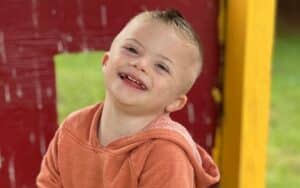Picture this: You’re playing with your baby, and even before they say their first word, they give you that warm smile, or they reach out for a toy. That right there is the world of non-verbal communication, and it’s huge for our little ones. Before they use verbal language, children are speaking a whole different language – one of gestures, facial expressions, and actions. And for them, understanding and using this silent language is just as vital as the words they’ll soon learn. In this article, we will shed light on child non-verbal communication and why and how parents can support it.

What is Non-verbal Communication?
Think of non-verbal communication as all the ways we “talk” without actually speaking. It’s the big bear hug when they’ve missed you, the pointing when they want something, smiling when happy, or the covering their face during peek-a-boo. These actions and reactions help children express themselves, connect with others, and make sense of the world around them. It’s like they’re letting us in on their thoughts, even before they can put them into words.
The Neuroscience Behind Non-verbal Communication
The human brain is hard-wired to recognize and interpret non-verbal cues. These cues trigger reactions in the amygdala, a part of the brain responsible for emotions. Thus, a smile, a frown, or even a posture can set off a cascade of neurological events leading to feelings of happiness, sadness, or alertness, respectively. Non-verbal communication also activates mirror neurons which play a role in empathy, enabling us to ‘feel’ what another person might be experiencing.

Examples of Early Non-verbal Communication
- Eye Contact: Establishing and holding eye contact is one of the earliest forms of non-verbal communication babies learn.
- Smiling: A baby’s first smile is a sign they recognize and respond to caregivers.
- Crying: Through different pitches and intensities, babies can communicate hunger, pain, or the need for attention.
- Reaching Out: A gesture indicating a desire to be held or to touch or have an object.
- Pointing: Directing attention to an object or direction.
- Head Shaking: Indicating refusal or disagreement.
- Clapping: Expressing joy or approval.
- Waving: A form of greeting or saying goodbye.
- Hugging: Show of affection or comfort.
- Gesturing: Using hands to express or emphasize.
- Facial Expressions: Conveying feelings like surprise, disgust, or curiosity.
- Body Posture: Demonstrating confidence, defensiveness, or openness.

Ten Ways Parents Can Nurture Non-verbal Communication
- Be Expressive: Use facial expressions and gestures frequently.
- Maintain Eye Contact: This reinforces the importance of focus and connection.
- Imitation: Copy your child’s sounds, facial expressions, and actions and encourage their imitation of you (without pressure or expectation), reinforcing their attempts at communication.
- Play Games with Gestures: Peek-a-boo, for instance, teaches about anticipation, reciprocity, and surprise.
- Use Gestures Along and Signs with Words: Point when identifying objects. Use natural gestures and signs along with words.
- Encourage Dance: This helps in imitation and understanding body movements and rhythms.
- Provide Feedback: If a child points, Name what they are pointing to.
- Stay Attuned: Recognize and respond to your child’s non-verbal cues.
- Model Emotions: Show sadness, happiness, and anger appropriately so they learn to recognize and express these emotions.
- Always Associate Words: Whenever you or they use a gesture, say the corresponding word or words to build verbal communication.
FAQs
- Why is non-verbal communication important?
- Non-verbal communication lays the foundation for verbal communication including understanding language, emotions, social cues, and nuanced messages.
- At what age should children start exhibiting non-verbal cues?
- Infants start exhibiting non-verbal cues from birth through crying, and other behaviors like smiling emerge within the first few months.
- What if my child isn’t using many non-verbal cues?
- Every child develops differently. If concerned, consult with your pediatrician and a speech-language pathologist.
- Can non-verbal communication aid in language development?
- Yes, non-verbal communication precedes verbal communication and acts as a foundation for more advanced language.
- How does culture impact non-verbal communication?
- Cultural backgrounds can influence the interpretation and use of non-verbal cues. What’s considered polite or rude in gestures, touch, or eye contact can vary widely among cultures.
Additional Resources
- Nonverbal Communication and Body Language – HelpGuide.org
- Nonverbal communication | Description, History, Characteristics, & Variations | Britannica
- Nonverbal communication with children | Raising Children Network
- About 16by16 – First Words Project
Summary/Conclusion
Understanding and fostering non-verbal communication is essential for a child’s overall development. These cues not only bridge the gap before verbal communication develops but also enrich the spectrum of human interactions throughout life. As caregivers, understanding this language beyond words can open up more meaningful dialogues and connections with our children.




0 Comments